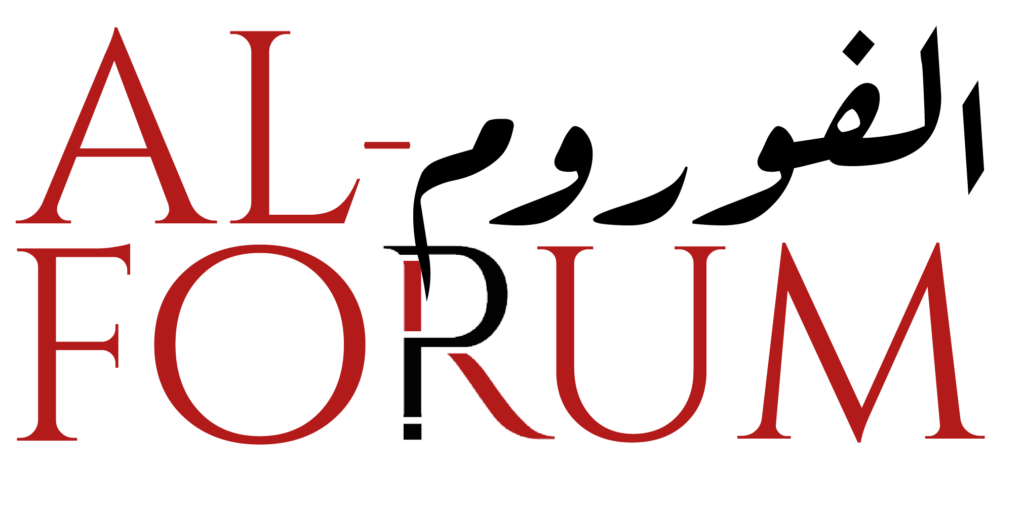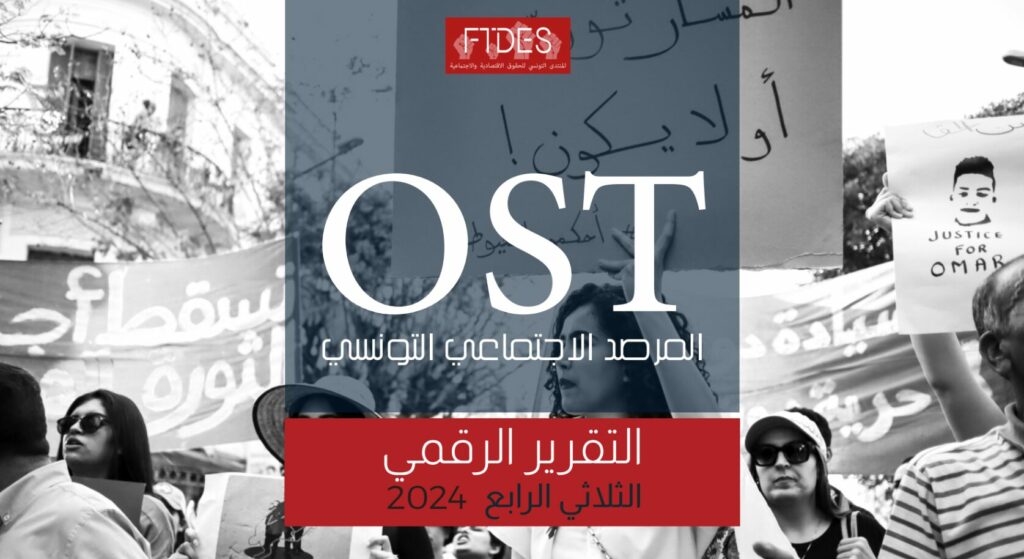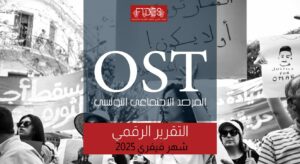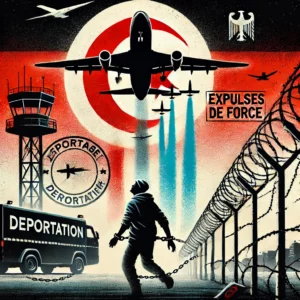Professional protests and requests for regularization dominate the last quarter of the year
The fourth quarter of the year was marked by 826 protests, compared with 752 in the third quarter, 586 in the second quarter and 475 in the first quarter.
The end of the year was characterized by the predominance of protests against acts of violence, which accounted for 17% of all protests.
A large proportion of these movements were associated with a state of anger and dissatisfaction, given that the period saw an increase in movements relating to professional and social conditions, which accounted for a third of all movements in the last quarter of the year, and concerned the improvement of working conditions, lack of equipment, professional regulations, the demand for payment of wages and subsidies, the right to work and promotion, the violation of workers’ rights, the right to trade union activity, the settlement of professional situations pending since the revolution, such as site workers, teachers and professors, the implementation of agreements, the securing of public health and education institutions, and arbitrary dismissals. ….
The workers’ movement at the “Ritun” leather and shoe factory in Sbikha was the most significant event of the fourth quarter of the year, having started in October and continued into November, recording the dismissal of 28 workers, the arrest of trade unionists and the indictment of more than nine people. The movement was widely supported by civil society organizations, human rights defenders and even artists and theater troupes.
The period was marked by movements against a backdrop of legal proceedings aimed at social actors in order to intimidate them and prevent them from continuing to make demands or protest.
These three months were also marked by protests by farmers and olive growers following the fall in olive oil prices. Citizen demonstrations took place because of coffee shortages, high prices and deteriorating economic and social conditions. Some of the movements were linked to basic public services such as health, education, infrastructure, breaking the isolation, improving roads, the right to development and poor services, making a total of 83 protest actions. The last quarter of the year also saw 13 environmental actions, 43 actions linked to the right to water and 5 actions linked to power cuts.
Individual cab drivers continued to demand their right to a license in several regions of the country. The unemployed and graduates are also back in action, demanding jobs, and delegations in Sfax have seen movements by citizens rejecting the presence of migrants from sub-Saharan African countries. The suicide of a teacher in Chebba after a campaign of intimidation on social media triggered a series of movements and protests among teachers in all the Republic’s governorates and was also adopted by the University of Secondary Education.
Movements in support of the Palestinian people continued, denouncing the aggression and massacres perpetrated by the Zionist entity in Gaza and demanding an end to the ongoing aggression. In addition, activists, human rights defenders and civil society organizations denounced violations of human rights and the right to freedom of opinion and expression, as well as the judicial process that subjects those arrested for their opinions and the conspiracy case to abuse and lack of justice.
According to the Tunisian Social Observatory team’s monitoring results, during the last quarter of the year, social actors relied mainly on vigils, which accounted for around 40% of recorded social movements, followed by calls through the media (111 calls), strikes (85 strikes) and sit-ins (85 sit-ins). The three months were marked by cases of discontent and anger, peaceful marches and marches towards the capital, wearing of red badges, blocking of roads, disruption of activities, burning of rubber tires, threats to stop work and threats to commit suicide.
Tunis topped the list of regions recording social movements with 137, followed by Kairouan with 110, Gafsa with 99, Medenine with 48, Kasserine with 42, Bizerte and Jendouba with 39 each, Sidi Bouzid 36, Nabeul 33, Sfax 30… Beja and Ariana came last with 7 movements each.
Teachers and professors (mainly substitutes) organized 198 protest actions in the last quarter of the year, citizens took part in 139 actions and workers and employees took part in 190 protest actions. Civil society activists took part in 71 actions, farmers in 37 and fishermen in 34. Students protested in 25 actions and individual cab drivers took part in 23. Parents, lawyers, students, the unemployed, site workers, public health workers, doctors, journalists, shopkeepers, sports fans and migrants also protested.
This breakdown in terms of social actors was reflected in the areas of protest, with educational establishments topping the list with 204 actions, the media with 104 calls and workplaces with 119 actions, while the share of public places and roads combined was 150 actions, including 21 on rue Habib Bourguiba in the capital, and the seats of delegations recorded 42 actions and the Gafsa phosphate company 38 actions, judicial institutions 19 actions, seats of sovereignty and ministries 29 actions, governorates 36 actions, and Place of the Kasbah saw two actions, as did the People’s Assembly.
The fourth quarter of the year saw 712 mixed movements, while 108 of these were attended solely by men and 6 by women. According to the monitoring team, 79.6% of movements were organized, while 20.34% were spontaneous. The movements can be broken down into 26 individual movements and 800 collective movements.
The last quarter of the year saw 22 suicide cases and attempts, 9 in December, 5 in November and 8 in October. Half of these (11 cases) took place in the private sphere (“home”), while the rest of the suicides took place in the public sphere, which hosted 9 suicide attempts and cases, including one in front of a governorate headquarters, with a theatrical scene. Workplaces were the scene of two suicides and one suicide attempt.
17 men committed acts of self-harm and suicide, compared with 5 women. In 14 of these cases, the suicide victim died, while the others were saved.
Bizerte and Kairouan recorded the highest number of suicides, with 5 cases each, followed by Mahdia and Tataouine with 2 each. Other governorates such as Ariana, Monastir, Beja, Sousse, Sidi Bouzid, Sfax, Gabes and Gafsa each recorded one suicide or suicide attempt.
In 40% of cases, the victims were young people, while adults accounted for around half of all recorded cases. One case of suicide involving a child was also recorded.
In the last quarter of the year, the Tunisian Social Observatory team continued to document and monitor incidents of violence, theft, robbery, sexual assault, harassment, rape, intimidation and murder, with a clear presence of digital violence, which continues to grow. Domestic violence and violence against women are also of note.
Violence retains the same characteristics of extremism and desire for revenge, and is therefore associated with theft, intimidation, revenge, harassment, sexual assault and bullying. Violence is not confined to public and private spaces, but extends to virtual and institutional spaces, mainly educational establishments, the media and tourist and leisure areas.
The majority of perpetrators are men, accounting for 93% of aggressors. Around 4% of violent acts were recorded in mixed form, and women committed only 2% of the violent incidents observed.
As far as victims are concerned, no gender was excluded from the recorded cases of violence. Men represented 57% of victims, women 34%, while mixed violence accounted for 9% of recorded incidents.
Individual violence accounted for 46.5% of recorded violence in the last three months of the year, while mixed violence between men and women represented 53.5%. Collective violence takes the form of assaults and robberies, for economic, protest or revenge purposes. Inter-individual violence includes sexual violence and murder, as well as aggression and the quest for domination.






